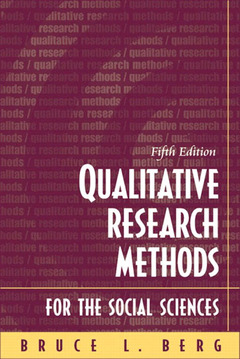Qualitative research methods for the social sciences
Langue : Anglais
Auteur : BERG Bruce

This text uses hands-on activities and real-life examples to provide the most comprehensive and straightforward coverage of doing qualitative research on the market . The author's central purpose is to show inexperienced researchers how to design, collect, and analyze data and then present their results to the scientific community, while stressing the importance of ethics in research and taking the time to properly design and think through any research endeavor.
Preface. 1. INTRODUCTION. Quantitative versus Qualitative Schools of Thought. Use of Triangulation Research Methodology. Qualitative Strategies: Defining an Orientation. From a Symbolic Interactionist Perspective. Why Use Qualitative Methods? A Plan of Presentation. 2. DESIGNING QUALITATIVE RESEARCH. Theory and Concepts. Ideas and Theory. Reviewing the Literature. Theory, Reality, and the Social World. Framing Research Problems. Operationalization and Conceptualization. Designing Projects. Data Collection and Organization. Data Storage, Retrieval, and Analysis. Dissemination. 3. ETHICAL ISSUES. Research Ethics in Historical Perspective. From Guidelines to Law: Regulations on the Research Process. Institutional Review Boards (IRBs). Ethical Codes. Some Common Ethical Concerns in Behavioral Research. New Areas for Ethical Concern: Cyberspace. Physical and Ethical Dangers in Covert Research. Informed Consent and Implied Consent. Confidentiality and Anonymity. Securing the Data. Objectivity and Careful Research Design. 4. A DRAMATURGICAL LOOK AT INTERVIEWING. Dramaturgy and Interviewing. Types of Interviews. The Interview Schedule. Schedule Development. Communicating Effectively. A Few Common Problems in Question Formulation. Pretesting the Schedule. Long versus Short Interviews. Telephone Interviews. Computer-Assisted Interviewing. An Unnatural Communication? The Dramaturgical Interview. The Interviewer's Repertoire. Know Your Audience. Analyzing Data Obtained from the Dramaturgical Interview. 5. FOCUS GROUP INTERVIEWING. What Are Focus Group Interviews? The Evolution of Focus Group Interviews. Advantages and Disadvantages of Focus Group Interviewing. Facilitating Focus Group Dynamics: How Focus Groups Work. The Moderator's Guide. Basic Ingredients in Focus Groups. Confidentiality and Focus Group Interviews. Recent Trends in Focus Groups. 6. ETHNOGRAPHIC FIELD STRATEGIES. Accessing a Field Setting: Getting In. Reflectivity and Ethnography. Becoming Invisible. Other Dangers During Ethnographic Research. Watching, Listening, and Learning. Computers and Ethnography. Analyzing Ethnographic Data. Other Analysis Strategies: Typologies, Sociograms, and Metaphors. Disengaging: Getting Out. 7. ACTION RESEARCH. The Basics of Action Research. Identifying the Research Question(s). Gathering the Information to Answer Question(s). Analyzing and Interpreting the Information. Sharing the Results with the Participants. The Action Researcher's Role. Types of Action Research. Photovoice and Action Research 8. UNOBTRUSIVE MEASURES IN RESEARCH. Archival Strategies. Physical Erosion and Accretion: Human Traces as Data Sources. 9. HISTORIOGRAPHY AND ORAL TRADITIONS. What Is Historical Research? Life Histories and Historiography. What Are the Sources of Data of Historical Researchers? Doing Historiography: Tracing Written History as Data. What Are Oral Histories? 10. CASE STUDIES. The Nature of Case Studies. The Individual Case Study. Intrinsic, Instrumental, and Collective Case Studies. Case Study Design Types. The Scientific Benefit of Case Studies. Case Studies of Organizations. Case Studies of Communities. 11. AN INTRODUCTION TO CONTENT ANALYSIS. Analysis of Qualitative Data. Content Analysis as a Technique. Content Analysis: Quantitative or Qualitative? Communication Components. What to Count: Levels and Units of Analysis. Category Development: Building Grounded Theory. Open Coding. Coding Frames. Stages in the Content Analysis Process. Strengths and Weaknesses of the Content Analysis Process. Computers and Qualitative Analysis. Qualitative Research at the Speed of Light. 12. WRITING RESEARCH PAPERS: SORTING THE NOODLES FROM THE SOUP. Identifying the Purpose of the Writing: Arranging the Noodles. Delineating a Supportive Structure: Visual Signals for the Reader. Presenting Research Material. A Word About the Content of Papers and Articles. Write It, Rewrite It, Then Write It Again! A Final Note. Name Index. Subject Index.
Date de parution : 08-2003
© 2024 LAVOISIER S.A.S.



